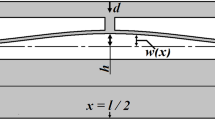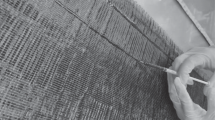Abstract
A composite material system comprised of a monostable negative stiffness (NS) structure within a polymer matrix was designed, fabricated, and experimentally evaluated. The monostable negative stiffness (NS) structure was designed using a combination of analytical and numerical models and manufactured in stainless steel. The NS structure was arranged in parallel with different polymer matrices to experimentally evaluate the effects of the matrix properties on the overall stiffness and energy dissipation of the composite NS-matrix system when loaded in uniaxial compression. A strong influence of the matrix properties on the stiffness and energy absorption capacity of the composite system was observed. Unlike conventional composites for which there is a natural tradeoff between stiffness and energy absorption capacity, the composite NS-matrix system enhanced stiffness while simultaneously improving energy absorption relative to a neat matrix, but only when the stiffness of the matrix was carefully matched to the stiffness of the NS structure.









Similar content being viewed by others
References
I.L. Vér (editor), L.L. Beranek (editor) (2006) Chapter 8. Sound-Absorbing Materials and Sound Absorbers, K. Attenborough, L. Vér. Chapter 14, Structural Damping, E.E. Ungar, J.A. Zpfe, in Noise and Vibration Control Engineering, Hoboken, NJ, John Wiley & Sons, Inc.
Sun CT, Lu YP (1995) Vibration damping of structural elements. Prentice Hall, Englewood Cliff
Jarzynski J (1990) Chapter 10. Mechanisms of Sound attenuation in materials. In: Sound and vibration damping with polymers. American Chemical Society, Washington D.C., pp 116–207
Dall’Astaa A, Ragnib L (2006) Experimental tests and analytical model of high damping rubber dissipating devices. Eng Struct 28:1874–1884
Chung DDL (2003) Structural composite materials tailored for damping. J Alloys Compd 355:216–223
Zhao X, Yang J, Zhao D, Lu Y, Wang W, Zhang L, Nishi T (2015) Natural rubber/nitrile butadiene rubber/hindered phenol composites with high-damping properties. Intern J Smart Nano Mat 6(4):239–250
Byers L, Gandhi F (2009) Embedded absorbers for helicopter rotor lag damping. J Sound Vib 325:705–721
Gu HS, Itoh Y (2010) Ageing behaviour of natural rubber and high damping rubber materials used in bridge rubber bearings. Adv Struct Eng 13(6):1105–1113
Rasuo B (2010) Experimental study of structural damping of composite helicopter blades with different cores. Plastics Rubber Comp 39(1):1–5
Kumar R, Kant R, Pandey S, Asfer M, Bhattacharya B, Panigrahi PK, Bhattacharya S (2013) Passive vibration damping using polymer pads with microchannel arrays. J Microelectromech Syst 22(3):695–707
Onda Corporation, "Acoustic tables," [Online]. Available: http://www.ondacorp.com/tecref_acoustictable.shtml. [Accessed 20 February 2016]
Lakes, R. S. (Eds) K. Golden, G. Grimmert, R. James, G. Milton, P. Sen, "Elastic freedom in cellular solids and composite materials in Mathematics of Multiscale Materials, NY, Springer, 1998, pp. 129–153.
Lakes RS (2001) Extreme damping in composite materials with a negative stiffness phase. Phys Rev Lett 86(13):2897–2900
Wang YC, Ludwigson M, Lakes RS (2004) Deformation of extreme viscoelastic metals and composites. Mater Sci Eng 370:41–49
Callister WD, Rethwisch DG (2009) Materials science and engineering and introduction. Wiley, Hoboken
Qiu J, Lang JH, Slocum AH (2004) A curved-beam Bistable mechanism. J Microelectromech Syst 13(2):137–146
Lakes RS, Lee T, Bersie A, Wang YC (2001) Extreme damping in composite materials with negative stiffness inclusions. Nature 410:565–567
Vangbo M (1998) An analytical analysis of a compressed Bistable buckled beam. Sensors Actuators A Phys 69(3):212–216
Klatt T, Haberman MR (2013) A nonlinear negative stiffness metamaterial unit cell and small-on-large multiscale material model. J Appl Phys 114:033503
Alabuzhev P, Gritchin A, Kim L, Migirenko G, Chon V, Stepanov P (1989) Vibration protecting and measuring systems with quasi-zero stiffness. CRC Press, Hemisphere, New York
Balandin DV, Bolotnik NN, Pilkey WD (2001) Optimal protection from impact, shock, and vibration. Taylor and Francis, Philadelphia
Kent RW, Balandin DV, Bolotnik NN, Pilkey WD, Purtsezov (2007) Optimal control of restraint forces in an automobile impact. J Dyn Syst Meas Control 129:415–424
Platus DL (1999) Negative-stiffness-mechanism vibration isolation systems, in SPIE conference on current developments in vibration Control for Optomechanical systems. Vol. 3786, Denver
Fulcher BA, Shahan DW, Haberman MR, Seepersad CC, Wilson PS (2014) Analytical and Experimental investigation of buckled beams as negative stiffness elements for passive vibration and shock isolation systems. J Vib Acoust 136(031009):1–12
Kashdan L, Seepersad C, Haberman M, Preston SW (2012) Design, fabrication, and evaluation of negative stiffness elements using SLS. Rapid Prototyp J 18:194–200
Correa DM, Klatt T, Cortes S, Haberman M, Kovar D, Seepersad C (2015) Negative stiffness honeycombs for recoverable shock isolation. Rapid Prototyp J 21(2):193–200
Correa DM, Seepersad CC, Haberman MR (2015) Mechanical design of negative stiffness honeycomb materials. Integr Mat Manufac Innov 10(4):1–11
Shan S, Kang SH, Raney JR, Wang P, Fang L, Candido F, Lewis JA, Bertoldi K (2015) Multistable architected materials for trapping elastic strain energy. Adv Mater 27(29):4296–4301
Rafsanjani A, Akbarzadeh A, Pasini D (2015) Snapping mechanical metamaterials under tension. Adv Mater 27(39):5931–5935
Pontecorvo ME, Barbarino S, Murray GJ, Gandhi FS (2012) Bistable arches for morphing applications. J Intell Mater Syst Struct 24(3):274–286
Harne RL, Wu Z, Wang KW (2016) Designing and harnessing the metastable states of a modular Metastructure for programmable mechanical properties adaptation. J Mech Des 138(2):1–9
Restrepo D, Mankame ND, Zavttieri P (2015) Phase transforming cellular materials. Ext Mech Lett 4:52–60
Florijn B, Coulais C, van Hecke M (2014) Programmable Mechanical Metamaterials. Phys Rev Lett 113(17):175503
Fritzen F, Kochmann DM (2014) Material instability-induced extreme damping in composites: a computational study. Int J S Struct 51:4101–4112
AK Steel, "AK Steel," 07 2007. [Online]. Available: http://www.aksteel.com/pdf/markets_products/stainless/precipitation/17-4_ph_data_bulletin.pdf. [Accessed 2 04 2016]
Stratasys, "Stainless steel 17–4," [Online]. Available: https://www.stratasysdirect.com/wp-content/themes/stratasysdirect/files/material-datasheets/direct_metal_laser_sintering/DMLS_Stainless_Steel_17-4_Material_Specifications.pdf. [Accessed 10 05 2016]
Citim, "Metal additive manufacturing," [Online]. Available: http://www.citim.de/en/metal-additive-manufacturing. [Accessed 10 5 2016]
Roland CM (2006) Mechanical behavior of rubber at high strain rates. Rubber Chem Technol 79:429–459
Acknowledgements
The authors acknowledge the National Science Foundation for supporting this research under grant CMMI #1435548. We would also want to acknowledge the Consejo Nacional para Investigaciones Científicas y Tecnológicas, CONICIT and the Ministerio de Ciencia y Tecnologia de Costa Rica, MICIT for their support under grant FI-0117-12. We would also like to thank Dr. David Bourell for allowing the use of scientific equipment required for this study and Stratasys Direct Manufacturing, Austin, Texas, for assistance with the stainless steel powder products.
Author information
Authors and Affiliations
Corresponding author
Rights and permissions
About this article
Cite this article
Cortes, S..., Allison, J., Morris, C. et al. Design, Manufacture, and Quasi-Static Testing of Metallic Negative Stiffness Structures within a Polymer Matrix. Exp Mech 57, 1183–1191 (2017). https://doi.org/10.1007/s11340-017-0290-2
Received:
Accepted:
Published:
Issue Date:
DOI: https://doi.org/10.1007/s11340-017-0290-2




